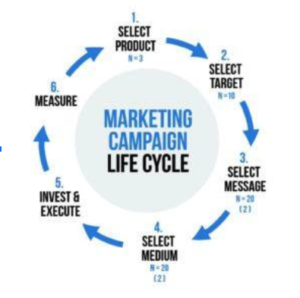With seemingly unlimited places to spend your marketing dollars, clients ask us if we can nail down three things in almost every study we do:
- What is the right message to win over customers?
- Which customer segments should I be targeting?
- Which mediums should I be using to maximize ROI?
And they should be asking these three questions if they want to close more business. Just getting close on any one of these can be a game changer for any business.
But when we start down this path with clients, we typically find they really don’t understand the magnitude of variables involved in their marketing campaigns.
Well, lucky for you, the nerds at PROOF have done the math and will explain it in simple, relatable terms.
Most marketing campaigns involve making decisions in six stages: product, target market, messages, mediums, investment and measurement. Here is a simple example of a typical campaign cycle (not necessarily in chronological order) to illustrate the variables associated with the process.

Product: Select a product or service you want to promote. Let’s say for the sake of simplicity that you only have three products or service offerings. In reality I know you likely have many more.
Target: How many target market segments do you have? This can vary widely depending on your business, but let’s say you have only 10 possible targets segments. (Note: If you only have 10 target segments you better be incredibly specialized, or you likely aren’t segmenting your customers effectively.)
Message: The number of possible messages you can communicate is infinite, but typically marketing and leadership get together and make a short list and pick one or two to roll with. Let’s say that list only has 20 options, and you pick two you think might work well.
Medium: The number of marketing mediums are really countless, anything from a simple email drip campaign to Snapchatting and running Facebook Live while giving hot air balloon rides at an industry convention. Not all of them are applicable to every business, so let’s say you are reasonably considering only 20 options and selecting two to invest in.
Invest & Execute: Once you and your team have selected which product, target market, message and medium you are going to use, all you have to do is organize, invest and execute your campaign. No problem, this is what you pay them for.
Measure: Now let’s hope you have you have taken the proper steps to create your funnel and measure the effectiveness of this campaign. The overall campaign will look something like the chart below. Now it’s time to cross our fingers and pray for positive ROI…
The actual number of possible combinations of this wildly simplified example is….
1,083,000
So that’s one in 1,083,000. Basically, you would have a better chance of being struck by lightning in the next 12 months (one in 960,000) or being crushed by a meteorite (one in 700,000). So, how probable do you think it is you are getting the best results out of your marketing efforts? If you have been following along, and you guessed “about 0%” you would be right – actually, it’s 0.000092336%.
What’s more troublesome is the fact that, in the event you DID happen to get one or more of the variables correct, there is no way to know.
So, for instance, let’s say you got the target market correct based on the product you selected, but you got every other variable wrong, and your campaign had negative ROI. Most marketers’ instincts are to try an entirely new set of variables or simply A/B test one variable. Regardless of what you do or how well you measure behavioral output, there is simply no way you could know which parts of this equation you had correct and which you missed on.
What can you do to improve your odds?
Keep your campaigns clear. We see many campaigns that are really creative, but they often lack a clear purpose, messaging and goals. A mentor of mine always said “clarity above cleverness, always.” Good advice.
Show discipline. Marketing and advertising have turned into a slippery slope game of tactics and mediums. Our attention spans are shrinking and so is our patience to see results. Trying new things can be addicting, especially when we don’t see immediate success. You likely chose your campaign messages and tactics for a reason, so stick with it for a bit.
Get your blocking and tackling nailed down. Generally, we see that few organizations do any one thing really well on the marketing front, while the more successful organizations we see execute one or two tactics incredibly well. Get really good at a couple of basics that support your business strategy and align with your customers’ preferences (i.e., email and SEM) and leave the experimental mediums for when you are confident and have discretionary funds.
While it is easy to get overwhelmed with the number of possible options of products, targets, messages and mediums, your best odds to produce positive ROI are to keep it simple and limit experimentation. If you are ready to experiment beyond your core marketing competencies, it might make sense to engage an expert to help you understand the probabilities of success using different mediums to minimize wasted efforts and dollars.
Lucky for you, PROOF’s process allows you to isolate the variables associated with your different products and services and your different target market segments, value messages and communication mediums. Instead of guessing, we reverse engineer all of these variables and can show you what to say, to which people, using what mediums so you are confident in your strategy and spending and can close more business.

Grant Gooding is an emotional-data thought leader; speaker; and marketing and neuroscience nerd. He is founder and CEO of PROOF Positioning, a market research firm that specializes in emotional data.

